I tried 12 famous red sauces, and the major brands couldn't compete with the specialty jars

- I tried red sauce from 12 brands, including some restaurant and artisan selections.
- The best options were the formulas from Michael's of Brooklyn and Rao's Homemade.
I tried 12 red sauces from major manufacturers and restaurant or artisan brands.
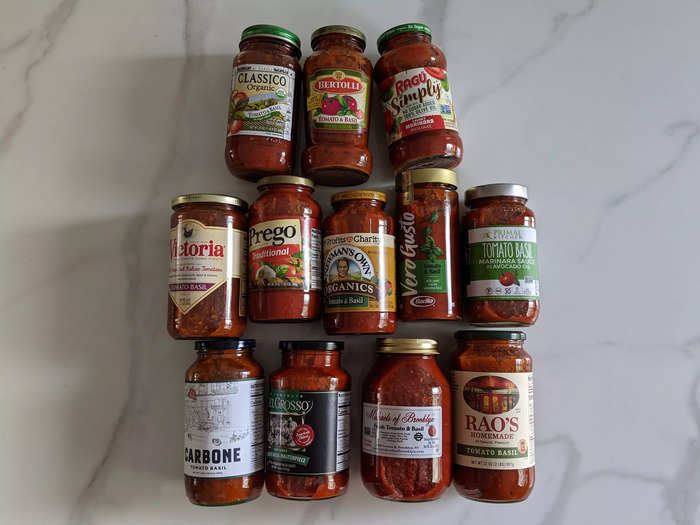
I grew up on Long Island, New York, where it's called sauce, not gravy (unless you're making it on a Sunday with a heckton of meat) and "cheating" with a jarred formula earns you a whack with a wooden spoon.
Still, supermarket shelves are stocked with an array of convenient options, though it's hard to know which actually live up to the hype and hefty price tags.
So I tried 12 basic, nationally distributed red sauces to find out.
I chose tomato-and-basil formulas as opposed to marinara since freshness-forward recipes are better for gauging the quality of the tomatoes and brightness of the seasonings, which can get muddy if there's a high proportion of oil. Additionally, marinara sauce can get thinned out over pasta because of its strained nature, which would defeat the purpose of the review.
I first tried all of the pasta sauces on their own straight out of the jars to get a baseline before the heat would activate the acidic and herbaceous notes.
I then heated up 2 tablespoons of sauce spooned onto cooked, unsalted, and unoiled pasta for 14 seconds in the microwave. This method expedited the liquefaction of the sauce, so I could better critique the emulsification.
As for the pasta, I opted for Banza chickpea-and-pea cavatelli for its medium size and ability to grip onto sauce within its ridges and hollow center.
Read on to find out how these different sauces stacked up.
I kicked off this taste test with easily accessible budget classics, starting with Prego's traditional red sauce.
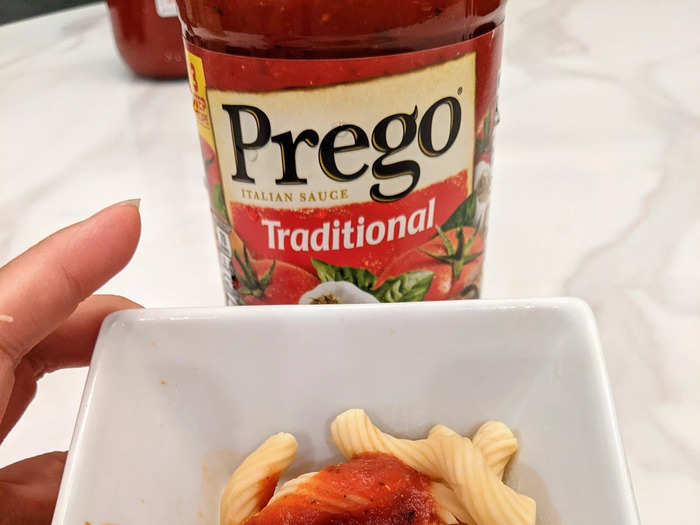
A well-known brand sold in supermarkets nationwide, Prego seemed like a good place to begin.
Stirring the sauce, I found it had a medium consistency with some cubed tomato chunks. It tasted sweet from the get-go, and even more so when returning to it after trying the others.
It had a soupy, artificial flavor that reminded me of SpaghettiOs if you were to add diced tomato and some puree to thicken it up, which made sense since both brands are owned by Campbell's.
Warmed up, this already-watery sauce thinned out only a little bit more, but it got really sweet, the sugars concentrating with a caramel-like quality and becoming the prevalent theme.
It lost its SpaghettiOs flavor and became like a rich, thick ketchup with a mind of its own in that it preferred sliding off the pasta rather than clinging to it.
I chose Bertolli's regular tomato-and-basil sauce because it had more visible basil than the company's organic version.
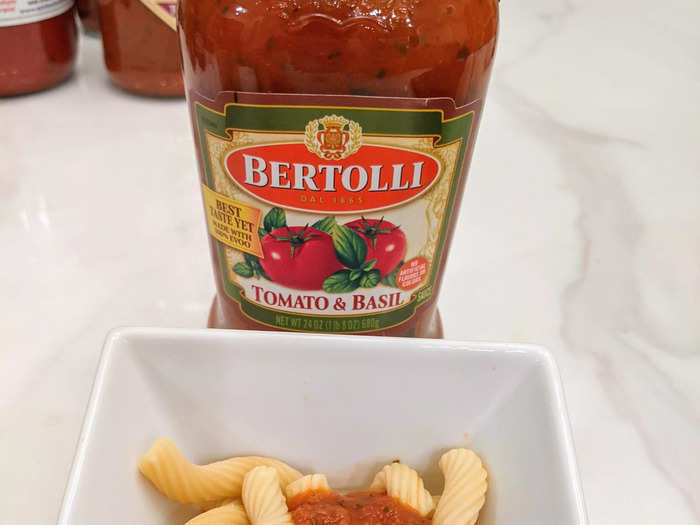
I opted for Bertolli's classic tomato-and-basil sauce, which featured generous amounts of big, rough-cut basil. Like every sauce in the brand's lineup, this one is made with real olive oil.
The clunky globs that stuck to the lid gave away this sauce's mass-produced nature, but that reminder was easily forgotten after the first stir.
Offering a coarse pureed texture punctuated by irregular chunks of cooked-down tomatoes and lots of visible and obviously fresh herbs, it felt similar to the red sauces from restaurants.
Even cold, it had a warm flavor, like a caprese salad at the height of summer — slightly sweet, but not overly so, accented by the impression of wilted fresh basil left out a bit too long.
This basil got a bit more mature-tasting once heated, losing some of its brighter green notes while still staying noticeable.
The sauce itself got watery enough to slide off the pasta, acting more like a puree than the chunky treat it was fresh out of the jar. This separation helped dilute the taste of the tomato paste I initially detected, and this sauce remained a pleasure.
Barilla's Vero Gusto line of red sauce is made in Italy, so I had high expectations.
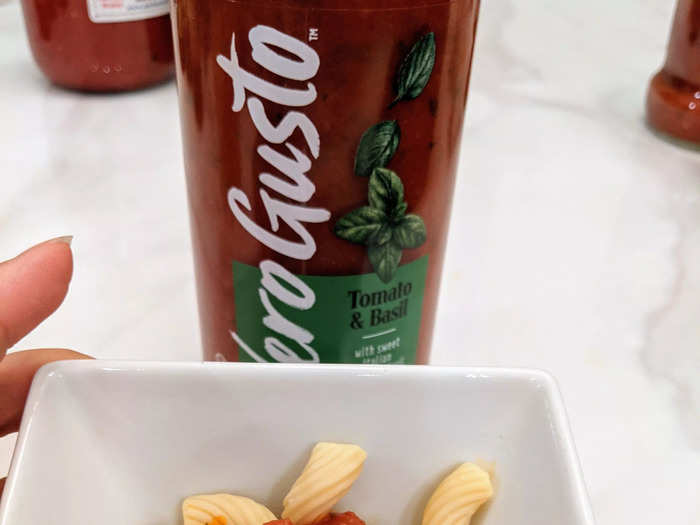
Barilla has made a huge name for itself in the pasta world, with over 130 years to perfect its craft.
It recently released a new line of geographically influenced recipes, boasting the inclusion of Italian tomatoes, extra-virgin olive oil, Genovese basil, and no artificial ingredients.
When I excitedly opened the jar, I revealed a deep, clean lid with no caked-on — or over-reduced — sauce on it, hefty pieces of tomatoes, and visible garlic floating up top.
The taste of tomato was strong and immediate, with a bit of a bite at the end that was emphasized by the strong presence of black pepper and the signature spiciness of Genovese basil.
This earthiness built toward the middle of the bite, when a cheese-like richness — most likely because of the carrots added as a natural acid counterpoint and sweetener — emerged.
On pasta, it was bold, hearty, thick, and chunky, grabbing firmly to each piece to make sure every ridge was coated.
Not only did the sauce get richer and sweeter from the heat, but its harder edges smoothed out. The previously noticeable black-pepper flavor backed off and the basil blended, making each bite impactful, yet not jarring.
Though it's affordable and accessible, Classico's organic sauce was disappointing.
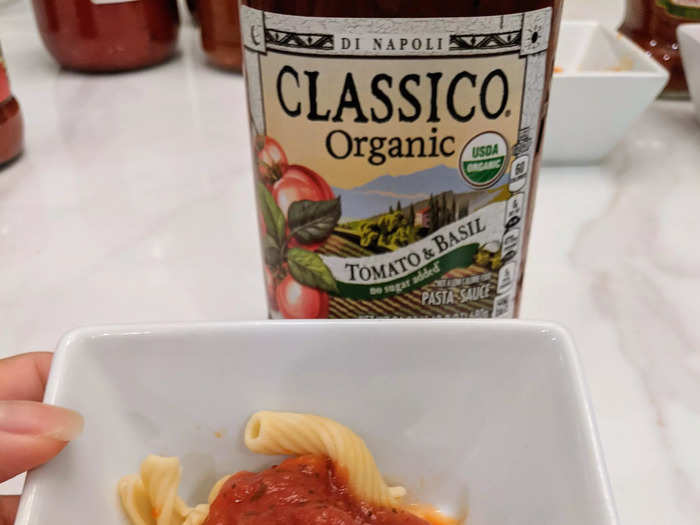
It was hard to pick a tomato-and-basil recipe to represent this brand since there are three options — regular, sweet, and spicy — in Classico's regular lineup alone.
I opted for this organic version as a more virtuous interpretation of the basic recipe, thinking that would mean it was better than the standard product. I was wrong.
This option was the most watery of the bunch, its liquidity interrupted by big cuts of tomatoes that were clearly added to a thin puree.
Eaten cold, it tasted exactly like salsa. The onion was sharp and young, the bell pepper was obvious, and the basil's flavor was nonexistent. The recipe appears to omit fresh basil for the faded, dry alternative, perhaps explaining why the other ingredients were overpowering.
It seemed clear no sugar was added since it finished with a harsh kick, most likely from the use of tomato paste to boost its flavor concentration.
It surprisingly extruded little liquid when warmed, but the change in temperature didn't do much to influence my impression. It smelled like warm salsa and tasted like it, too.
This tomato-and-basil sauce from Newman's Own is also organic.
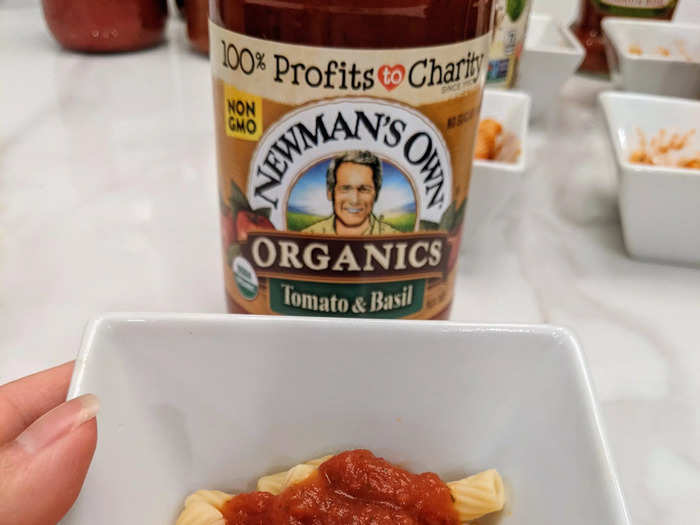
The Newman's Own organic tomato-and-basil sauce had a few more ingredients and a much bigger halo than the nonorganic alternative.
I found a thinner puree, though, with tomatoes that were clearly added in as opposed to cooked together, which is typical for major manufacturers.
Straight from the jar, the tomato flavor was warm and the black pepper stood out, supported by the distinctive fennel.
Unfortunately, its concentrated syrupy flavor and acidity lingered a bit too long, ineffectively countered by the pureed carrot.
Once heated, it looked sadder — plain and nondescript. Appearances proved to be deceiving, however, as it got significantly better.
I could now taste the basil, even though the tiny flecks had faded, and the overall flavor of the sauce strengthened with a deeper sense of tomato.
Plus the thinner, kid-friendly texture proved to be a boon, refusing to water down or separate and evenly coating the pasta.
I opted for Ragù's chunky marinara, which is part of the chain's Simply line.
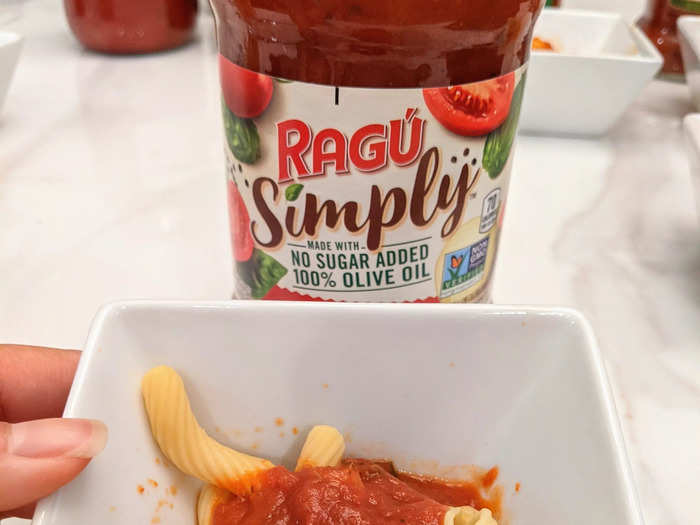
An over 80-year-old company with origins tracing back to Naples, Ragù interestingly has only one meat sauce in its collection — despite its namesake dish — and not a single basic tomato-and-basil option.
So I chose to try one from the Simply line — which was launched in 2018 as an upgraded option made with real olive oil and no sugar — since it's the brand's fanciest product and more likely to be a fair contender.
Opening up the jar, it seemed that Ragù took the "simply" promise a little too far. It was very smooth except for the infrequent bites with thrown-in diced tomatoes.
There was a pervasive musty flavor that tasted like tomato paste past its prime accented by overly caramelized notes that ended with a syrupy aftertaste. This was probably the sweet potato's thumbprint on the recipe, which is a practical choice to pair with carrots as a natural sweetener despite this poor execution.
This strange mustiness persisted even after heating the sauce and was the strongest impression given the lack of visible herbs and spices.
Plus the experience was short-lived. Despite there not being a lot of separation once warmed, and therefore more tomato on the pasta, the sauce's flavor was fleeting.
Primal Kitchen's sauce is quite pricey for being from a mainstream brand.
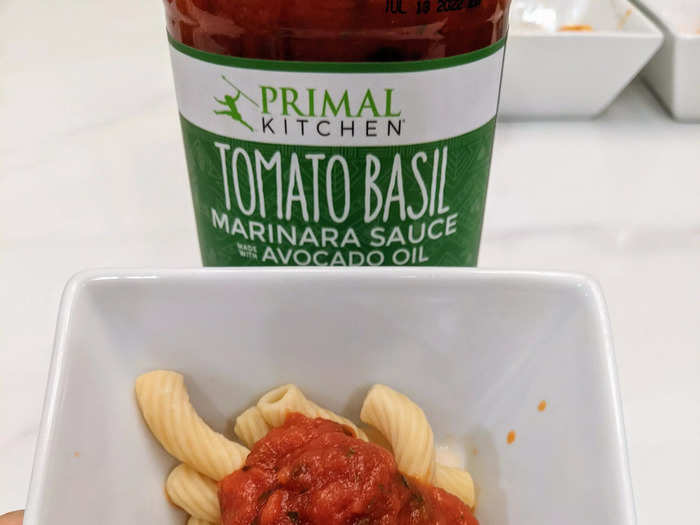
This option boasts an absence of gluten and grains — an odd flex since those ingredients aren't common in any red sauces.
The brand has a loyal following among the paleo, keto, and Whole30 communities and a shocking price tag on par with the restaurant sauces, so I was curious to see whether it'd prove itself worthy.
At first glance, it was brightly, cheerfully red, with oversize pieces of clearly fresh basil floating in a sea of gloriously thick puree.
Diced tomatoes are named first in this ingredient list, denoting a higher concentration. I suspected, based on their shape and texture, that they were actually simmered in the puree and not added as an afterthought.
The tomatoes were on the acidic side, but the basil came through sweet, and the oregano was warm.
But the microwave ended this honeymoon. Though the sauce stayed nice and thick, pleasantly hugging the pasta, the flavors dramatically changed.
The basil got sharper, but not in a fresh way. The acid became pronounced to the point of abrasion. Plus a piercing, horseradish-like tang emerged, as if someone spilled cocktail sauce in my pasta.
When warmed, the salt also had a rather salty taste.
I then moved on to the restaurant and artisan brands, starting with tomato-basil sauce from Rao's Homemade.
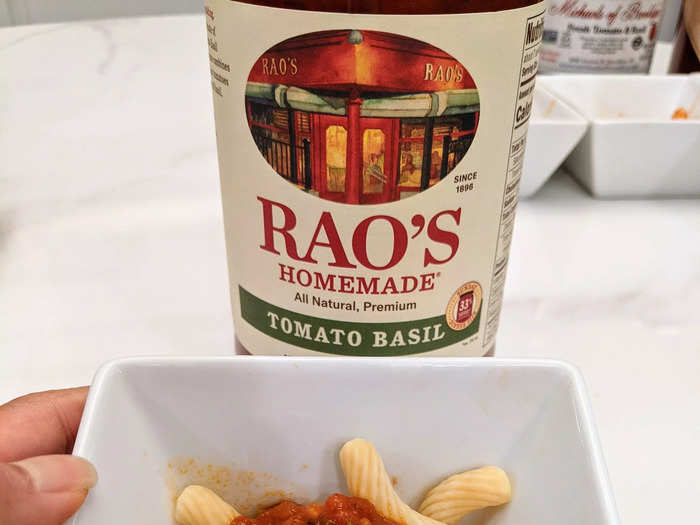
The restaurant Rao's is a New York City legend for its exclusivity. With its tradition of "table rights" — all of the seats are reserved for regulars, and you can't get in unless you're invited to dine as a guest — chances are most of us will never experience what the fuss is truly all about.
That said, this sauce was a vision of naturally broken-down, whole tomatoes that were coarsely and unevenly melted into a slurry, just as the good gods of red sauce intended.
It was generously sprinkled with sweet basil leaves and stems, punctuated by dark spots of olive oil, which I tasted right away.
There was an immediate richness to this sauce — a slow-cooked, smoky flavor not present in any of the previously tasted options.
Warming it led to some separation between the tomato juice and solids, but that didn't stop it and the chopped basil from elegantly draping over the pasta.
Its profile developed a fuller body and aromatically opened up as the tomatoes got bolder and warmer. It also got significantly saltier and the umami flavor became more pronounced, leaving me craving meat and wine.
In short, it lived up to the hype.
In addition to being a sauce maker, Carbone is a Michelin-star restaurant.
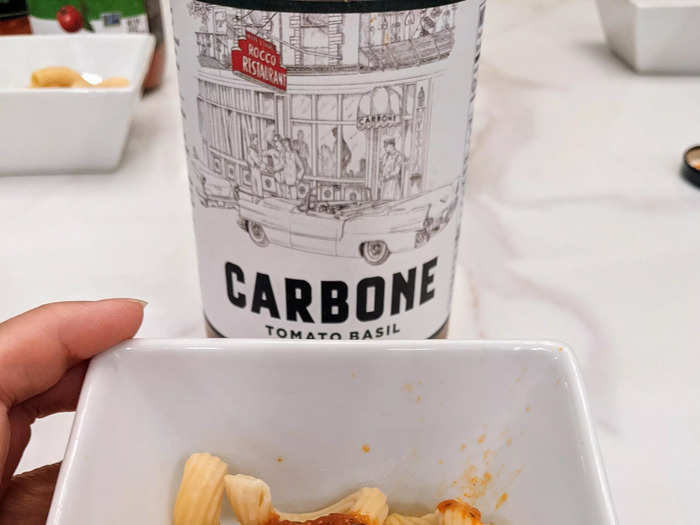
This restaurant's 2013 opening has made quite a mark on the New York City food scene.
Between its old-school dining experience, exclusivity hook with reservations released only once a week, mega-powered ownership, and Michelin-starred cuisine, its success is strategic — and so is its sauce's formula.
At first glance, it was considerably darker than the other sauces — a deep brick with scarlet oil splotches and visibly wilted fresh basil.
It was already sweet and rich when cold, and though it uses puree, whole tomatoes are listed first in the ingredients, which was evident in its chunky texture.
There was a lingering whole-mouth feel to the sauce, with a malty, mushroom-like sense and a reminder of cheese, even though none is used in the recipe.
It immediately struck me that this is the kind of sauce you'd want to put on a thick, breaded cutlet for chicken Parmesan.
This impression got stronger after it was warmed and mixed into the pasta, to which it clung well.
The maltiness opened up to be less mushroom-like and more reminiscent of caramelized onions. It was a flavor that was hard to place and difficult to define, but not unpleasant.
There was a little tartness at the end to counterbalance the earthiness for an overall satisfying bite that would be made better only with chicken and mozzarella.
This sauce from Michael's of Brooklyn was a standout.
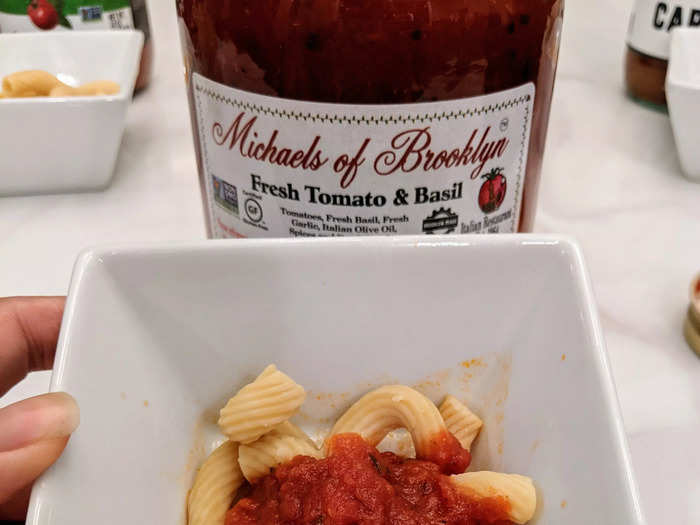
Michael's of Brooklyn is a three-generation family-owned joint that has operated out of the same location on the edge of Marine Park since 1964.
The pasta sauce is still cooked and packed at the source, and its label holds onto that mom-and-pop feeling with simple branding and multiple exclamation points at the end of its short ingredient list.
In this case, short was sweet. Right out of the uniquely squat jar, this sauce immediately lived up to every word of its fresh tomato-and-basil title.
The color popped, a gloriously vivid red even lighter than that of Primal Kitchen's sauce.
The little bit of olive oil used in the sauce's slow cooking was well incorporated and invisible to the eye, while big, green basil leaves leisurely floated in the hearty mix.
My eyes literally opened wider with joy as it hit my taste buds, with a real "wow" factor that only quality ingredients and careful cooking can provide.
This was super clean — bright and lively with a taste like softly warmed tomatoes picked at the peak of ripeness and chopped up with fresh, sweet basil. It trailed off with the faintest ghost of garlic.
The balance in this sauce was like a symphony — mild and nonacidic while still presenting flavor and character, simple but not plain as its ingredients took turns shining in each mouthful, and sweet without being cloying.
I steeled myself for a letdown when I saw how much it watered down when heated, but it was still awesome, sweet in an uncontrived, natural way with a tomato flavor that sang even louder.
I still tasted the basil and parsley, but those herbs politely took a back seat to the fresh tomato flavor that brought me right back to a summer visit to Southern Italy.
Though the sauce didn't coat the pasta too well and reintegrate as willingly as others, I didn't mind. It was so good that I would happily have sipped it like soup and asked for more.
Another Brooklynite, Victoria has been producing red sauce since 1929.

Victoria uses a 90-minute kettle-cooking process — a direct challenge to mainstream manufacturers that use heat-transfer tubes to flash cook their sauces — that results in a beautiful texture of whole tomatoes broken down in their own juices until irregularly lumpy.
Without puree, the base was a little on the waterier side, but the coarse tomatoes were plentiful enough that it wasn't runny.
As with the sauce from Carbone and Rao's, I could see some oil floating, but I more noticed the diced onions, tomato seeds, and smaller pieces of basil, which were dark and fine.
It tasted clean and fresh, sweet at first, then suddenly sharp before it tapered off into sweet again — a lovely ride.
Unfortunately, this journey ended early when the sauce was served warm. The flavor considerably lightened up and became fleeting and shallow.
The basil remained detectable, distributing well and evenly across the pasta in its tiny pieces, but the tomato lost a lot of its freshness.
It just wasn't very assertive, even though the water didn't separate as much as expected. Not devoid of personality but in need of a partner, this would pair well with high-quality or fresh pasta.
From the oldest family-owned sauce producer in America, this DelGrosso formula rounded out the dozen.
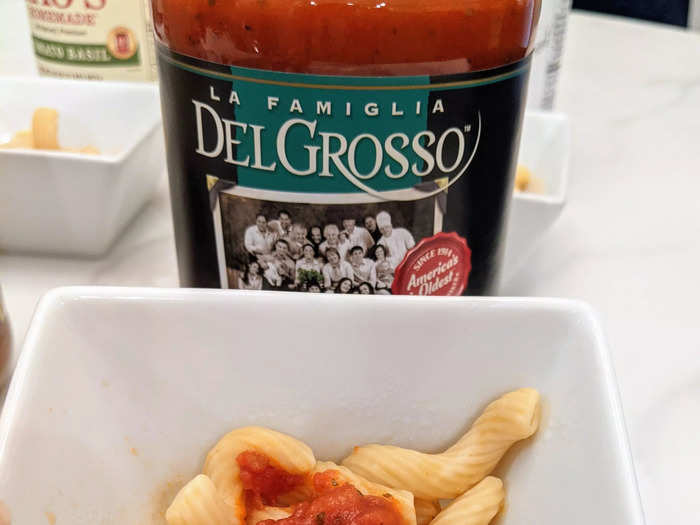
The end of my taste test surprisingly took me to Pennsylvania, where an Italian immigrant named Marianna Pulcino opened Mom's Café.
From there (and a segue into an amusement park), the business has become the oldest major family-owned manufacturer of pasta sauce in the US.
I tried Chef John's Tomato Basil Masterpiece, a part of the brand's "ultra-premium" line.
There was no oil floating around in what can best be described as a nice sauce. It was inoffensive and had good intentions — safe, pure, but not refined.
When the sauce was served cold, the readily apparent garlic and onions felt and tasted almost raw, and the whole tomatoes seemed as if they weren't given the time to blossom despite the brand's pride in slow cooking.
Microwaving the sauce with pasta briefly pulled out some of the wateriness, but it got reabsorbed remarkably well. The flavor got sharper and more acidic, and the onions continued that impression. Unfortunately, the basil flavor disappeared.
The sauce did a decent job of sticking to the pasta, and on the whole, it was a good, middle-of-the-pack option that was just nice.
There was a clear difference between the major manufacturers and the specialty brands.
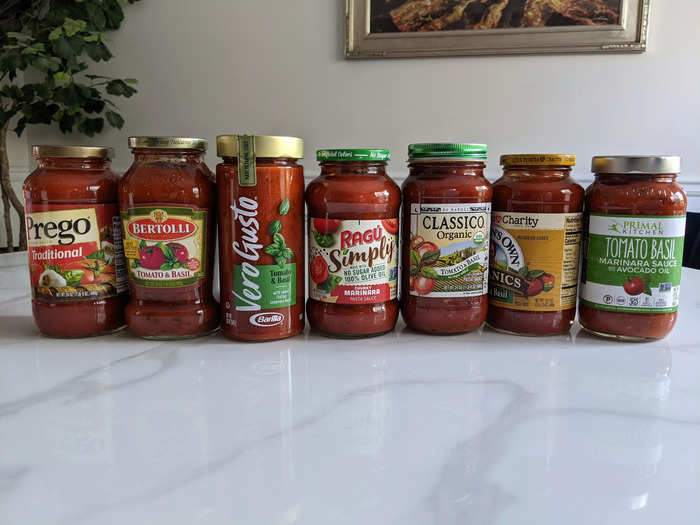
The restaurant sauces were glaringly identifiable from those by more recognizable brands.
As similarly mass-produced as some of these big names may be today, there's just no mistaking the thick, chunky viscosity of cooked-down, whole tomatoes.
Among the major manufacturers, two distinguished themselves as excellent and two were clearly the worst.
I'm not even counting Classico's sauce since it just seemed like salsa, but Ragù's option had a muddy, syrupy aftertaste, and Prego's tasted a bit too recognizable and cheap.
Bertolli's formula stood out with its rougher puree, lovely tomatoes, and fresh basil flavor, and Barilla's Vero Gusto sauce sported a unique and distinctive basil variety, forward tomatoes, and an overall complexity.
Most of the fancier options lived up to their hype and proved to be superior.
Michael's of Brooklyn was the best if you like clean, fresh, and sweet tomatoes that trill like the finest soprano. But Rao's followed as a close second or tie, with layered flavors and a miraculous meatiness for a vegetarian recipe.
READ MORE ARTICLES ON
Popular Right Now
Advertisement